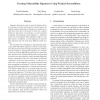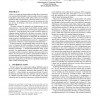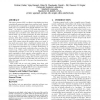42 search results - page 8 / 9 » Augmenting Branch Predictor to Secure Program Execution |
CSFW
2007
IEEE
13 years 11 months ago
2007
IEEE
Signature-based tools such as network intrusion detection systems are widely used to protect critical systems. Automatic signature generation techniques are needed to enable these...
OOPSLA
2005
Springer
13 years 10 months ago
2005
Springer
is a simple and elegant abstraction that allows concurrency to be expressed often through a relatively small rewrite of a sequential program. In the absence of side-effects, futur...
SP
2010
IEEE
13 years 9 months ago
2010
IEEE
—Fuzz testing has proven successful in finding security vulnerabilities in large programs. However, traditional fuzz testing tools have a well-known common drawback: they are in...
DATE
2003
IEEE
13 years 10 months ago
2003
IEEE
Smart cards are vulnerable to both invasive and non-invasive attacks. Specifically, non-invasive attacks using power and timing measurements to extract the cryptographic key has d...
CCS
2006
ACM
13 years 9 months ago
2006
ACM
This paper presents EXE, an effective bug-finding tool that automatically generates inputs that crash real code. Instead of running code on manually or randomly constructed input,...



